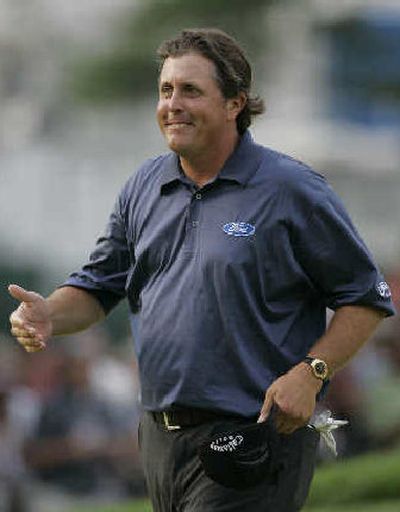Mickelson charges to front

MAMARONECK, N.Y. – Exit Tiger Woods. Enter Phil Mickelson.
Is the U.S. Open becoming a microcosm of golf in general? It will if Mickelson continues to attack Winged Foot the way he did on Saturday’s back nine.
While Woods spends a quiet, reflective Father’s Day at home after missing the cut, his closest rival will try to put away his third straight major when he starts the day tied for the lead with Kenneth Ferrie, a 27-year-old Englishman who is playing the third tournament of his career in America.
Ferrie’s compact swing and fiery temperament have held up under the duress of extreme U.S. Open conditions but really, this isn’t about him. It is Mickelson’s tournament to win, the way it used to be for Woods.
“He loves it,” said his swing coach, Rick Smith, after Mickelson shot 1-under-par 69 to draw even with Ferrie (71) at 2-over 212 for the tournament. “It’s what he’s prepared for. It’s what he’s worked so hard for. This is what his life is all about. It’s being in position to win another major.”
It would be Mickelson’s first U.S. Open title and put him one win away from replicating Woods’ feat of holding all four major trophies simultaneously. Mickelson, though, chided a reporter for bringing that up.
“I’ve got 18 holes (today) and I have not ever won this trophy and I’m just trying to win one,” he said. “Right now, I’ve got a great chance to fulfill a dream to win a U.S. Open and have a lot of work to do.”
If Mickelson looks over his shoulder, he will see Geoff Ogilvy, the steely Aussie, one shot back; Vijay Singh and Colin Montgomerie three back; and ‘03 champ Jim Furyk, Mike Weir and Padraig Harrington lurking four shots off the lead. Those are the big names who have survived this far.
None of them, however, indeed no one in the field the first three days, has played the kind of golf that Mickelson played while taking just 33 strokes on the back nine. After finding just two of his first nine fairways (“playing from the rough and fighting for pars,” he said), Mickelson hit the last five and started to take on treacherous pins that no one else was willing to challenge, picking up birdies on Nos. 14 and 16.
“It’s as good as it’s been when it’s been really good,” Smith said of Mickelson’s suddenly confident swing. “Something clicked for him and he got the feel. You could tell he knew exactly what he had to do and he did it.”
Mickelson’s run, which produced one of the day’s two under-par rounds, started while others were making mistakes and losing strokes.
There was second-round leader Steve Stricker, playing the final six holes in 4-over, his driver leaving him in the high stuff.
There was Harrington, en route to a triple-bogey, trying to hit a utility club out of the thick rough on No. 18 and topping it 15 feet.
There were Weir and David Duval, each hitting bunker shots that rolled off the 18th green.
There was Graeme McDowell, playing with Mickelson, watching his chip shot roll back to his feet on No. 18.
Finally, there was Ferrie, three-putting the final green to fall back into a tie with Mickelson, already in the clubhouse.
It easily could have been said that the setup was too hard, that if the USGA was going to grow the rough so high, it shouldn’t have set so many pins five paces from the edge or cut fairways at 20 yards. Then Mickelson made it look so easy that he called it fun later.
“Every year, one time a year, we get tested like this and I love it,” he said. “I love being tested at the highest level of the most difficult and sometimes ridiculous golf course setups we’ll ever see. But I love it because I get to find out where my head is really at and it really challenges me as a player.”
That’s a pretty good way to think with 18 more ridiculous holes coming up.
As Smith said, “I like his momentum going into (today).”